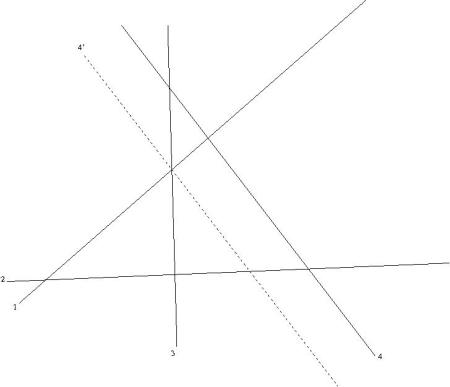Well,
It has been long since I have written anything about cake-cutting. Anyways, in this post I am going to describe the best known deterministic algorithm for cake-cutting.
Let’s say we want to divide the cake between 4 people. We can let p1,p2,p3 mark a line which will divide the cake in two equal halves according to their own perceptions (captured by evaluation function ).
Say for example, p1,p2 and p3 marks line as shown in the figure. Because odd number of persons have cut the cake we can have a middle line. We will cut the cake at this line. Ask p4, whether the piece on the left or right is at least half according to his perception. If p4 selects the left half, then play cut and choose between p4 and p1 for the left piece and for p3 and p2 for the right piece. It is easy to work out the solution in case p4 selects the right piece.
What if there are odd number of people? Say 5. In this case, we will ask p1 to p4 to mark the lines which will cut the cake in the ration 2:3 from the left. Ask, p5 if he thinks whether the left piece is worth at least 40% or the right piece is worth 60%. As argued above, we can divide group into bunch of 2 and 3 and recurse.
So in general, if n is even, ask first n-1 people to cut the cake in the ratio of 1:1. If n is odd, ask first n-1 people to cut the cake in the ratio (n-1)/2 : (n+1)/2. And then ask which piece the n-th person thinks is worth at least its declared value.
It is easy to see that this algorithm works in time . This is the best known deterministic algorithm for simple fair division.
It has been conjectured that the simple fair division can not be achieved in with a deterministic discrete ( unlike moving-knife algorithm ) algorithm. Many believe that the lower bound for simple fair division, where queries to evaluation function is not free, is
. However, it is an open question that remains to be answered.
— Saurabh Joshi

